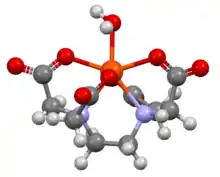Ferric EDTA
Ferric EDTA is the coordination complex formed from ferric ions and EDTA. EDTA has a high affinity for ferric ions. It is a yellow solid that gives yellowish aqueous solutions.[1]
 | |
| Names | |
|---|---|
| Other names
(ethylenedinitrilo)tetraacetatoferrate | |
| Identifiers | |
3D model (JSmol) |
|
| ChemSpider | |
| EC Number |
|
PubChem CID |
|
CompTox Dashboard (EPA) |
|
| |
| |
| Properties | |
| C10H12FeN2O8 | |
| Molar mass | 344.057 g·mol−1 |
| Appearance | yellow |
| Hazards | |
| GHS pictograms |  |
| GHS Signal word | Warning |
| H315, H319 | |
| P264, P280, P302+352, P305+351+338, P321, P332+313, P337+313, P362 | |
Except where otherwise noted, data are given for materials in their standard state (at 25 °C [77 °F], 100 kPa). | |
| Infobox references | |
Synthesis and structure
Solutions of Fe-EDTA are produced by combining ferrous salts and aqueous solutions of EDTA known as Jacobson's solution.[2]
Near neutral pH, the principle complex is [Fe(EDTA)(H2O)]−, although most sources ignore the aquo ligand. The [Fe(EDTA)(H2O)]− anion has been crystallized with many cations, e.g., the trihydrate Na[Fe(EDTA)(H2O)].2H2O.[3] The salts as well as the solutions are yellow-brown. Provided the nutrient solution in which the [Fe(EDTA)(H2O)]− complex will be used has a pH of at least 5.5, all the uncomplexed iron, as a result of incomplete synthesis reaction, will still change into the chelated ferric form.[4]
Uses
In contact with aerated natural waters, iron salts convert to the ferric form. Near neutral pH, ferric ions form insoluble solids and are thus not bioavailable. EDTA (and other chelating agents) address this problem, by forming soluble complexes that resist formation of hydroxides.
Together with pentetic acid (DTPA), EDTA is widely used for sequestering metal ions. Otherwise these metal ions catalyze the decomposition of hydrogen peroxide, which is used to bleach pulp in paper making. Several million kilograms EDTA are produced for this purpose annually.[5]
Iron chelate is commonly used for agricultural purposes to treat chlorosis, a condition in which leaves produce insufficient chlorophyll. Iron and ligand are absorbed separately by the plant roots whereby the highly stable ferric chelate is first reduced to the less stable ferrous chelate.[6] In horticulture, iron chelate is often referred to as 'sequestered iron' and is used as a plant tonic, often mixed with other nutrients and plant foods (e.g. seaweed). It is recommended in ornamental horticulture for feeding ericaceous plants like Rhododendrons if they are growing in calcareous soils. The sequestered iron is available to the ericaceous plants, without adjusting the soil's pH, and thus, lime-induced chlorosis is prevented.
Iron chelate has also been used as a bait in the chemical control of slugs, snails and slaters in agriculture in Australia and New Zealand. They have advantages over other more generally poisonous substances used as their toxicity is more specific to molluscs.[7]
Ferric EDTA is also used to control some broadleaf weeds in lawns. On the other hand, these molecular ions may also serve as plant available iron nutrients in a blend of modified Hoagland and Long Ashton solutions.[8] According to Jacobson (1951), the stability of ferric EDTA was tested by adding 5 ppm iron, as the complex, to Hoagland's solution at various pH values. No loss of iron occurred below pH 6.
Related derivatives
Aside from ferric EDTA, iron complex of EDDHA is used to make the iron soluble in water and, for the purposes of agriculture, accessible to plants.[9]
In iron chelation therapy, deferoxamine, has been used to treat excess iron stores, i.e. haemochromatosis.[10]
References
- Xue, Hanbin; Sigg, Laura; Kari, Franz Guenter (1995). "Speciation of EDTA in Natural Waters: Exchange Kinetics of Fe-EDTA in River Water". Environmental Science and Technology. 29: 59–68. doi:10.1021/es00001a007.CS1 maint: uses authors parameter (link)
- Jacobson, L. (1951). "Maintenance of Iron Supply in Nutrient Solutions by a Single Addition of Ferric Potassium Ethylenediamine Tetra-Acetate". Plant Physiology. 26 (2): 411–413. doi:10.1104/pp.26.2.411. PMC 437509. PMID 16654380.CS1 maint: uses authors parameter (link)
- Solans, X.; Font Altaba, M.; Garcia-Oricain, J. (1984). "Crystal Structures of Ethylenediaminetetraacetato Metal Complexes. V. Structures Containing the [Fe(C10H12N2O8)(H2O)]− Anion". Acta Crystallographica Section C. 40 (4): 635–638. doi:10.1107/S0108270184005151.CS1 maint: uses authors parameter (link)
- Steiner, A.A.; van Winden, H. (1970). "Recipe for Ferric Salts of Ethylenediaminetetraacetic Acid". Plant Physiology. 46 (6): 862–863. doi:10.1104/pp.46.6.862. PMC 396702. PMID 16657561.CS1 maint: uses authors parameter (link)
- J. Roger Hart "Ethylenediaminetetraacetic Acid and Related Chelating Agents" in Ullmann's Encyclopedia of Industrial Chemistry, Wiley-VCH, Weinheim, 2005.doi:10.1002/14356007.a10_095
- Van Driel, W. (1964). "The effect of iron ethylenediaminetetraacetic acid on the growth and metabolism of tomato plants in water culture". Plant and Soil. 20: 85–104. doi:10.1007/BF01378101.CS1 maint: uses authors parameter (link)
- Young CL, Armstrong GD (2001). "Slugs, Snails and Iron based Baits: An Increasing Problem and a Low Toxic Specific Action Solution". Australian Society of Agronomy. The Regional Institute. Retrieved 2009-10-18.
- Nagel, K.A.; Lenz, H.; Kastenholz, B.; Gilmer, F.; Averesch, A.; Putz, A.; Heinz, K.; Fischbach, A.; Scharr, H.; Fiorani, F.; Walter, A.; Schurr, U. (2020). "The platform GrowScreen-Agar enables identification of phenotypic diversity in root and shoot growth traits of agar grown plants". Plant Methods. 16 (89): 1–17. doi:10.1186/s13007-020-00631-3.CS1 maint: uses authors parameter (link)
- Batra, P.P.; Maier, R.H. (1964). "Isolation and determination of the ferric iron chelate of ethylenediamine di(o-hydroxyphenylacetic acid) in plant tissues". Plant and Soil. 20: 105–115. doi:10.1007/BF01378102.CS1 maint: uses authors parameter (link)
- "Hemochromatosis: Monitoring and Treatment". National Center on Birth Defects and Developmental Disabilities (NCBDDD). 2007-11-01. Archived from the original on May 18, 2009. Retrieved 2009-10-18.